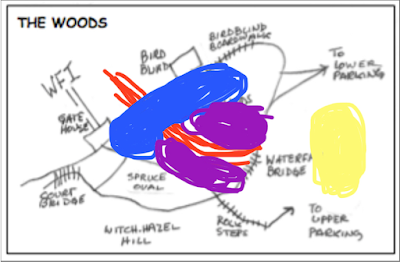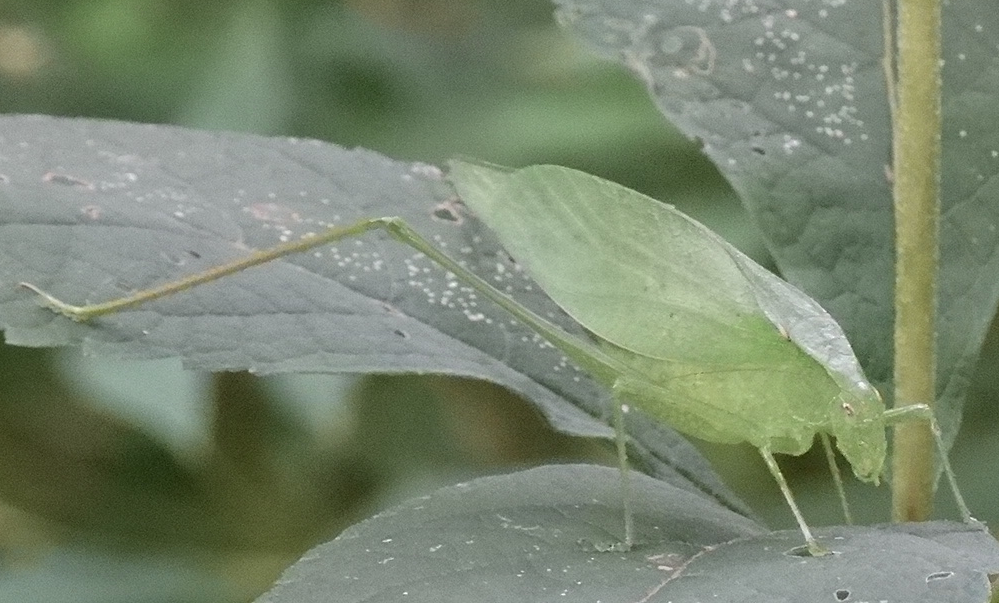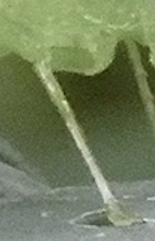This week’s bloomlist for Wildflower Island is at the end of the post, and Bonnie’s pictures from
about the same time in late May 2018 can be found HERE and in early June 2018 HERE.
Peterson names are used for consistency wherever possible, and comments and clarifications
are welcome in the comments section. Slightly revised towards the end...
I’m waiting for the deliciously rich smelling Swamp Azaleas R. viscosum, but have no problem settling for the sweeter Multiflora Rose Rosa multiflora.
We don’t have any official names that I know of, but I use the same general names as the landscape architect who assisted us with the restoration. The blue area: wetland pools, purple: open marsh, yellow: basin, red: swale. I don’t have a specific name for what you call Witch Hazel Hill, and general refer to it as “the hillside”.
Here’s what I’ve gleaned from discussions with Teatown staff and volunteers. The drainage from upper parking log is going down now into the new pool (yellow), where sediment is collected. It then flows down through what they’re calling the swale (red) under the new Birdblind boardwalk and into the lake through a trench. The swale and the wetlands areas either side of it (purple) were created essentially for education, and as such, many new flora have been planted there. Some of the water will drain out throught the trench (red), and some of it in the purple section closest to the lower parking lot is just expected to evaporate. At some point the dam will be fixed and the part of the lake between Birdblind and the Gatehouse will be dredged.
I have second thoughts about the name I gave the hillside back in 2018 — “Witch-hazel Hill — because the whole section of the Woods going up to the rocky ridge is so lush with vegetation that the newly planted, once prominent Witch-hazel trees have more or less disappeared into the general greenery.
It’s strikingly different from other grasses, with it’s pudgy florets. The individuals I saw didn’t have much in the way of awns (bristles), which can be very long or not there at all. Illinois Wildflowers says:
Occasionally, Wheat escapes from cultivation and self-sows. However, such escaped plants do not persist in the environment for very long. . . Wheat thrives in highly disturbed areas with exposed topsoil.Also in The Woods are some sedges, which with trepidation I’m thinking are from the left in the picture below: Eastern Narrow-leafed Carex amphibola, Rosy Carex rosea, and Oval-headed Carex cephalophora
You can of course get better shots of these in Google searches, but these are ours.
Both a smooth small Solomon's seal (to 3' tall) and a great Solomon's seal (to 7' tall) are native to eastern North America. There is unanimous agreement that the smooth small Solomon's seal is P. biflorum. There is considerable controversy, however, as to what to call great Solomon's seal. Current trends seem to be to include great Solomon's seal as a variety of P. biflorum, namely, as P. biflorum var. commutatum. However, the small and great Solomon's seals do differ considerably (e.g., plant size, flower/fruit size, leaf vein arrangement and number of flowers per axillary cluster) so that a number of authorities have assigned great Solomon's seal separate species status, to wit, as P. commutatum, P. canaliculatum or P. giganteum, all of which are varyingly considered to be synonymous with P. biflorum var. commutatum.


























































